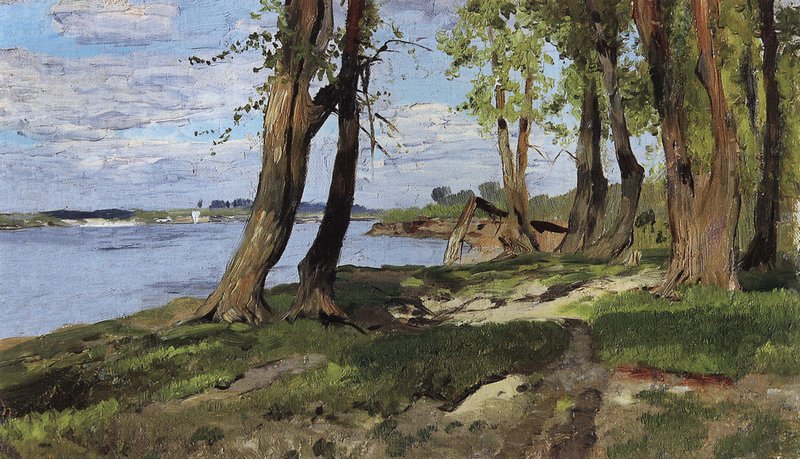A planetary detox
In
Log in if you are already registered
“Nature is a sea of forms, radically alike and even unique.”
(Emerson)
The image of Russia that arises is a vast natural expanse, sprinkled with churches, mostly of wooden materials, as that is all that was affordable following the Mongolian invasion. The Russian nature is crystal clear and neat, with pure primary colors as exist at the core of each segment of the prism. A serious blue, but not deep indigo blues. A serious green, but none of dark hues. When the churches are illuminated by sunlight: they have a light yellow overtone. Habitually, there is a coolness in the colors. The coolness arises from the freshness and cleanliness of the water of snow. It’s the harsh winters that keep the stoicism of the natural environment. Whilst the absence of pervasive human settlement, enshrines the spirituality. It is a place that Emerson and Jon Muir would revel in, like the greatness of the national parks in the United States. As Emerson writes, “The law of harmonic sounds reappears in the harmonic colors.” Thereby, the bells ring across the vast expanses with the clarity of the purest sounds.

Isaac Levitan On The Volga. Near the shore.
Sketch, Canvas on wood, oil. 14 x 24 cm
The culmination of this vastness of the Steppe, comparable to the hinterland of the North American West, are the fortresses, known as Kremlin, which guard series of churches within themselves. Unsurprisingly, the armory at the Moscow Kremlin holds jewels of overwhelming beauty, and this is the paradox, which is characteristic of the Russian style, whereby like alchemists the Russian diplomates transform war into peace, weapons into diamonds. By this I mean the capacity of the Russians to dramatically change domestic policy and regime, to avoid and minimize international war and the loss of life of civilians. Exchanging Bolshevism for Peace in World War One, Communism in one country rather than global revolution to conclude the Second World War, top down capitalist and democratic transition to overcome the division of the Cold War. The end of the Cold War was as much a victory for the Russians and Eastern European states as it was for Western Europe and the United States, because peace was preserved. What is more, the process of restructuring the communist society directly led to an experiment to create democratic unity across Eurasia. A project that is being implemented in a piecemeal fashion at this time, with growing pains, and has been seriously hampered by the pressure created for the states at the seams of the Eastern and Western expanses of the continent to choose a single orientation, East or West. Rather these middle states should acting as a bridge to unite and heal the drift in opposite directions of the Chinese and European states, and the location of the unifying innovative energy infrastructure. It’s a different question than the NATO one, as the cultural, economic, social integration can happen at different levels of existence and sovereignty.
Entering the Kremlin walls across a footbridge, one has the sentiment to be standing upon a dome, like the golden domes of the Orthodox churches, and this dome extends and expands further and beyond towards the Pacific Ocean, the Arctic circles, or to the clean alpine deserts of the Southern Caucususes , the Tibetian mountain plains and pristine lakes, to encounter the congested of European settlement.
It is from this pinnacle that one could imagine the spirituality that rises like a staircase in the minds of the Russians. The Russians themselves are not aware of this national trait, that spells their uniqueness. They tend to compare themselves to their neighbors , understanding their existence in contrast or comparison with the self confidence and insularity of the Chinese, or the philosophical might of their German neighbors, the grayness of the Polish. What the Russians reflect is this spiritual height , its characteristic of their heightened sense of honor, culminating in the love duels in the past , but also in today’s refusal to identify themselves with their Europeanness, as a foundational part of the continent’s political and social evolution. As Emerson writes, “A leaf, a drop, a crystal, a moment of time is linked to the whole, and particles of the perfection of the whole. Each particle is a microcosm, and faithfully renders the likeness of the world.” and it so that the cleanliness of Russian thought is reflected in the minds of each, to the minds of the others.
It is then at this impasse that I must underline that the Russian hold within themselves the ability to create an enlightenment, because they are enlightened, though they do not flaunt it or even recognize it. This enlightenment arises along transcendental lines, though they themselves do not identify it as such, and though they remain unfamiliar to the parallel between the transcendental thought and that of the Russian pre Soviet liberal trains of thought. Though Lomonosof, the great founder of the oldest university in Russia and drafter of the Russian grammar textbooks, advocate for the use of the Russian language in instruction. Yet for all the Russian philosophy, the focus is on unity, and few Russian philosophers outside the monastic traditions have considered the Russian nature as a source of freedom. In the Russian philosophical thought, the natural trend is towards unity. Nature and the expanses of territory are considered in a narrative of comprehension and gathering together, unity. The liberation factor of the mind is not elucidated. Notably the natural capacity to set man free, is what has enabled Russian’s at each critical moment of their history to reorientate their foreign policy to conserve human values and peace.
So when at the political and economic level we have come to an impasse, it is possible and essential to simply move the domestic environmental policies in a similar direction, so that there is a convergence of economic basis, notably of the knowledge based economy within the next four decades making the societies compatible. This convergence in the longterm would replace the natural bifurcation occurring and that will be the permanent consequence of Russia and China continue in the petroleum based capitalist production, whilst Europe continues its post petroleum industrial program towards the knowledge society.
Whereas regional integration, as the Chinese Eurasian model is showing is based upon logistical infrastructure projects. Only with a set of common values can the greater Eurasian and European Union develop beyond a mere infrastructural project. The challenge in creating the new electrical connections has a twofold direction:
1) a dedicated system to collect, analyze and organize the environment
2) creation of an environmental monitoring mechanism
As these are being planned anew in the East these can and should reflect the new ecological standards but also technological capabilities, for example, integrating solar power and wind use , the infrastructure for electrical vehicles even of hovering capacity. Erstwhile, rather than arguing about the route of gas pipelines, a major reason or indicator of conflict, it is necessary to develop the new infrastructure for delivery of clean energy and electricity, capitalizing at the vast natural resources of Russia as clean energy provider and store of O2.
Dual use and dual infrastructure is the modern day Emerson lightbulb.
Considering the micro-structure of the EU Russia energy interaction is the objective of this report. It begins with what are the technological capacities.
As Emerson writes the connections to be established through infrastructure are “…like a great circle and a sphere, encompassing all possible circles, which however, may be dreams and comprise it like movement. Every such truth is the absolute essence from one side.” Hereto, could be cited the Russian Futuristical poets, whom were electrified by the parallel revolutionary spark ignited by the new technological means of ceasing and creating power at the turn of the 20th century.
The Russian philosophical and technical contribution has been the conception of the vehicle and fuel, theoretical before even the flight of airplanes, of how to reach outer space. There by the likes of Tsiakolovsky lead the way to order, from anarchy. As is the trend of Cosmism, and has been said about butterfly effect, is repeating the same aspects on different scales. “This sort of manifestations of individuality in processes of enormous biogeochemical importance is a new planetary phenomenon.” Emeson 1838
Cosmos as environment is taking the foresight of the Russian cosmology program and applying it to the planetary level of the planet earth. The relationship between the theory of the polis, i.e. politics, and environmental conditions, i.e. the cosmos, can be traced back to the Aristotle. In fact, our myths of creation from Ancient Egyptian times, to the holy books, such as Genesis in the Bible, to the physics of the Big Bang, expresses with mathematical symbols the story of natural equilibrium and the birth of biological and organic times. What is devastating today is that our environmental myths are catastrophic, the very reverse from the natural myths of creation. Our anthropogenic activity thereby includes technological simulation of natural creation, that has de facto become unsustainable. Reaching other planets is a solution, but should only be the complementary nature of developing a sustainable technological life on our planet.
The establishment of the new centers of world energy will depend on the success of incorporating ecologically efficient technology, and as a matter of fact revolving this in the cost calculation.
In developing the new ecological infrastructure, the highest development of technology should be used.
The consideration is twofold: One is purely technological, the other is how the interests and identities of the political actors are expressed in the energy dialogue as from of conflict and cooperation. Let us hope that common interests take precedence over the damage that can be inflicted using energetical supply or denial of demand.
MSc in Political Science, Columbia University
Blog: Anna Maria Rada Leenders' Blog
Rating: 1




